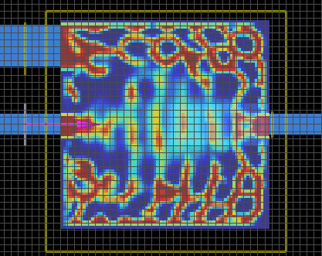By miniaturezitation of the photonic devices, increasing their functionality and converting carried energy efficiently into electric energy, it is obvious that in practice that will lead more widespread optical information processing and energy harvesting applications. Therefore, the examination of photon interaction with structures in the micro-meters and nano-meter order is important. The first work to be done in this direction, include the design of the nanophotonic environment.
The interaction of light with structures having a change in refraction index in order one wavelenght or less cause the presence of so many rich physical concept that can not be observed previously led researchers to do work in this area. For example, super-prism, self-collimation, negative refraction, super-luminal light, slow light, cavities with high quality factor, laser with a low threshold current surface modes, supercontinuum formation, epsilon-near-zero and issues such as the Dirac cone are carried out studies on the subject through the design and analysis of nanophotonic structures. When the photon interaction with nano-photonic structures are investigated numerical analysis methods become crucial.
It is possible to examine nanophotonic environments into two categories: conventional methods and non-intuitive approaches. Conventional methods are widely used in the analysis. The non-intuitive approaches are frequently used for optimization algorithms in recent years. There are a number of advantages of traditional approaches compared with non-intuitive approach.
The nano-photonic structure analysis, which are designed with the conventional approaches, are generally considered with specific configurations. For example, let’s consider the two-dimensional photonic crystal structure with square-lattice, by examining the general characteristics of the energy bands that occur under a specific dielectric filling ratio (the ratio of the amount of material to total area in the unit-cell) the physical phenomena can be observed which is listed above. Then by changing the structure parameters in a limited range the effect to be observed characteristic can be studied. One of the most studied topics in the design of photonic structures is photonic crystals. In addition to photonic crystals which has regular refractive index variation, the random regular refractive index variation or quasi-periodic crystals are among the issues being worked on as well. Finally the nano-photonic structures that inspired by the nature is concerned. In particular, the studies about structural color, display and thermal analysis are mainly analyse and test the structures inspired by nature.
When we try to explain the conventional design method for the nano-photonic artifact first a structure is taken into account and then the structure is analyzed using numerical methods. Observed physical concepts are not verified in experimental environment. The disadvantage of the conventional method is that after making the analysis one can understand if the structure exhibit the desired physical characteristics or not, based on the trial and error method. The studies that recently started to spread has a potential to be an alternative method of analysis, they are known as non-intuitive approach and optimization algorithms.



